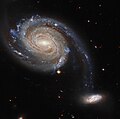Fayl:NGC7752, NGC7753 - HST - Potw2142a.jpg
Naviqasiyaya keç
Axtarışa keç

Sınaq göstərişi ölçüsü: 604 × 600 piksel. Digər ölçülər: 242 × 240 piksel | 483 × 480 piksel | 774 × 768 piksel | 1.031 × 1.024 piksel | 2.063 × 2.048 piksel | 3.908 × 3.880 piksel.
Faylın orijinalı (3.908 × 3.880 piksel, fayl həcmi: 3,2 MB, MIME növü: image/jpeg)
Faylın tarixçəsi
Faylın əvvəlki versiyasını görmək üçün gün/tarix bölməsindəki tarixlərə klikləyin.
| Tarix/Vaxt | Kiçik şəkil | Ölçülər | İstifadəçi | Şərh | |
|---|---|---|---|---|---|
| indiki | 05:11, 18 oktyabr 2021 |  | 3.908 × 3.880 (3,2 MB) | Fabian RRRR | == {{int:filedesc}} == {{Information |description={{en|1='''Invisible Galactic Gale NGC 4666 takes centre stage in this image from the NASA/ESA Hubble Space Telescope. This majestic spiral galaxy lies about 80 million light-years away in the constellation Virgo, and is undergoing a particularly intense episode of star formation. Astronomers refer to galaxies which are forming stars anomalously quickly as starburst galaxies. NGC 4666’s starburst is thought to be due to gravitational interact... |
Fayl keçidləri
Aşağıdakı səhifə bu faylı istifadə edir:
Faylın qlobal istifadəsi
Bu fayl aşağıdakı vikilərdə istifadə olunur:
- ar.wikipedia.org layihəsində istifadəsi
- be.wikipedia.org layihəsində istifadəsi
- ce.wikipedia.org layihəsində istifadəsi
- de.wikipedia.org layihəsində istifadəsi
- diq.wikipedia.org layihəsində istifadəsi
- en.wikipedia.org layihəsində istifadəsi
- eu.wikipedia.org layihəsində istifadəsi
- fa.wikipedia.org layihəsində istifadəsi
- fr.wikipedia.org layihəsində istifadəsi
- mg.wikipedia.org layihəsində istifadəsi
- mk.wikipedia.org layihəsində istifadəsi
- ru.wikipedia.org layihəsində istifadəsi
- sk.wikipedia.org layihəsində istifadəsi
- tt.wikipedia.org layihəsində istifadəsi
- www.wikidata.org layihəsində istifadəsi
